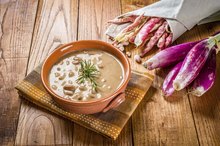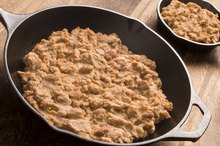What Vegetables Can You Eat on the hCG Diet?
hCG, which is short for human chorionic gonadotropin, is a hormone naturally produced during pregnancy. Supplement companies that manufacture the hormone claim that it can help your body rapidly burn off fat and shed those extra pounds. But aside from taking the hormone, you also have to make drastic cuts in your diet, limiting yourself to just 500 calories daily. You’re allowed to have vegetables while following the hCG plan, although you can only have certain types, and you have to measure your servings carefully.
Leafy Greens
Many types of leafy greens fit perfectly within your rigid hCG diet parameters. You can have spinach, Swiss chard, romaine, green leaf lettuce, iceberg lettuce, Boston lettuce, beet greens, cabbage, chicory and endives. One serving of leafy greens -- 1 cup of raw, chopped greens or 1/2 cup of cooked greens -- contains approximately 25 calories, according to the Academy of Nutrition and Dietetics.
Other Allowable Veggies
How Many Calories Are in Lettuce Wraps?
Learn More
You can have several other varieties of nonstarchy vegetables while sticking to your diet. Celery, fennel, tomatoes, red radishes, onions, cucumbers and asparagus are other vegetables you can fill up on. The calorie content is about the same as that of salad greens -- 25 calories per 1 cup raw or 1/2 cup cooked.
Cooking and Seasoning Vegetables
You’re not allowed to add any extra fat to your foods for cooking purposes. That means if you want to grill a few sprigs of asparagus or sauté onions to pile on your steak, you’ll have to use a nonstick cooking surface or minimal amounts of nonstick cooking spray. Drizzle your veggies with a squeeze of fresh lemon juice instead of using banned sauces or dressings. Or you can add a dash of salt, pepper or garlic powder to get a bit more flavor. Spices, as well as dried or fresh herbs, are also allowed on your hCG plan.
When to Eat Your Veggies
Dijon Mustard Nutrition
Learn More
The hCG diet regimen allows you to have one serving of vegetables at lunch and one serving at dinner. A 100-gram serving of meat, fish or seafood; a breadstick or cracker; and a small portion of fruit are other components of lunch and dinner meals. But you are allowed to split your meals apart. For example, if you like celery, save a few celery sticks for an afternoon snack rather than having them with your meal. Or you can throw together a small salad and instead of having it with dinner, enjoy it later in the evening.
Diet Warning
Following the hCG diet plan cuts out a large amount of food that you need for fuel. If you experience weight loss, it most likely stems from eating less, not necessarily from the hormone supplement. Before starting your diet, have a talk with your physician. He may be able to set you up with a registered dietitian, who can put together a healthy eating plan for you so you don’t have to make such extreme changes.
Related Articles
References
- EveryDiet.org: hCG Diet
- hCG Diet Info: The Original hCG Diet Menu by Dr. A.T.W. Simeons
- Academy of Nutrition and Dietetics; Choose Your Foods: Exchange Lists for Weight Loss
Writer Bio
Melodie Anne Coffman specializes in overall wellness, with particular interests in women's health and personal defense. She holds a master's degree in food science and human nutrition and is a certified instructor through the NRA. Coffman is pursuing her personal trainer certification in 2015.









